Historical Context
The Bourbon Dynasty:
The beginning of Louis XIV's reign in the eighteenth-century found France in an economically tense environment due to the number of battle losses suffered in the succession of wars that occurred, particularly the Wars of Spanish Succession. However, France retained its supremacy in Europe. Louis XIV died in 1715, ending his seventy-two year reign. The next in line to the throne was Louis XIV's five-year-old great-grandson, Louis XV. In his will, Louis XIV left almost everything to his mistress Madame de Maintenon. Philippe d'Orléans, the nephew of Louis XIV, appealed to Parlement in order to annul the will and place Philippe d'Orléans on the throne as Regent. Parlement annulled Louis XIV's will and installed Philippe d'Orléans as Regent for the young king. The portrait to the right is one of the most famous portraits of any monarch, which attests to the influence Louis XIV had in Europe. As noted with the earlier French monarchs, Louis XIV is garbed in ermine-trimmed robes), blue, and gold-embroidered fleur-de-lys, all of which are explicit symbols of status, wealth, and royalty. Take note of Louis XIV stance. Does his position denote power and authority? Does it denote his status in society? The exposed leg, perhaps to emphasize the virility and strength of the king, thereby the monarchy, is seen in portraits of Louis XIV's English contemporaries, seen here. Louis XIV is also depicted with a sword, scepter, and crown, which could represent his absolute authority over the military and the public. Perhaps in response to this painting, an anonymous artist, in a drawing, depicted Louis XIV without the royal regalia, illustrating the facility in which the façade of the king can be stripped away. | King Louis XIV (1643-1715) 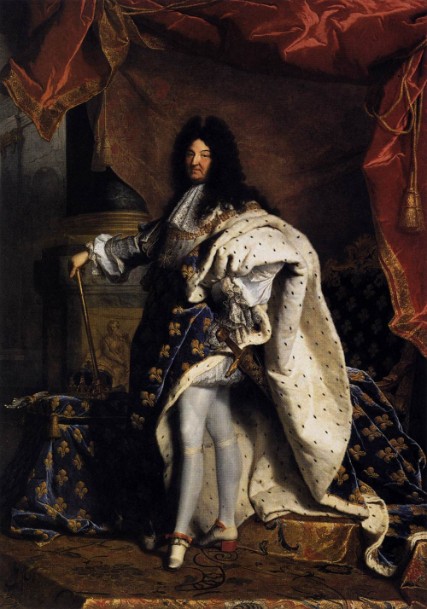 Hyacinthe Rigaud, ca. 1701 |
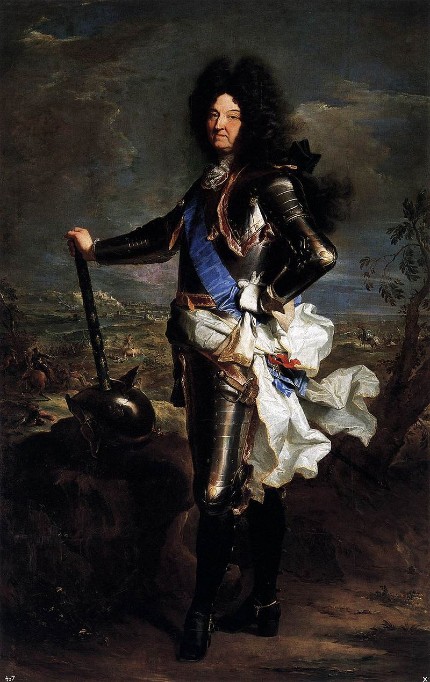 Hyacinthe Rigaud, ca. 1701, Museo del Prado, Spain | Louis XIV was extraordinarily involved in warfare, all the time looking after France's interests abroad. Through involving France in a number of foreign wars, France gained territory in Flanders and a number of alliances. The portrait to the left is a straightforward representation of Louis XIV's involvement and glorification of war. In his right hand, Louis XIV is depicted with a baton, a symbol of military authority, particularly amongst the royalty or high-up military officials. Note the stance of the king. Much like the portrait above, the position could refer to the virility and strength of the Sun King. Also, notice that the color blue is found in this painting, retaining that sense of royalty even amongst symbols of military might. |
Before becoming Regent, Philippe d'Orléans, known as the duc de Chartres, had a distiguished military career. After his older brother died, Philippe d'Orléans became the heir to his familial heritage and title of duc d'Orléans. Philippe d'Orléans became the Regent for Louis XV after his uncle, Louis XIV, died. As Regent, Philippe d'Orléans sought to bolster the monarchy's power in reaction to the loss beginning in Louis XIV's reign. Philippe d'Orléans continued to see to France's interests abroad and remained close to foreign policy. During Philippe d'Orléans rule, France and Great Britain united against Spain to secure the legitimacy of succession for the French throne. Spain withdrew its claim. Meanwhile, the costs of war were building up and Philippe d'Orléans fought to replenish the Treasury, however, the national debt would be a legacy for Louis XV and ultimately lead to the French Revolution during the reign of Louis XVI. The Regency ended when Louis XV came of age in 1723. The king appointed Philippe d'Orléans as a cabinet minister. Philippe d'Orléans died four months after his appointment. Noting that Philippe d'Orléans, in his early years, forged himself a military career, how does the representation to the right instill a confidence in the monarchy to the beholder? Note also that Philippe d'Orléans is pictured with a blue baton covered in gold fleur-de-lys. The baton symbolizes military control. In what ways is this portrait similar to that of Louis XIV's? | Philippe d'Orléans (Regent: 1715-1723) .jpg) Jean-Baptist Santerre, ca.1715-1723, Museo del Prado, Spain |
King Louis XV (1715-1774) 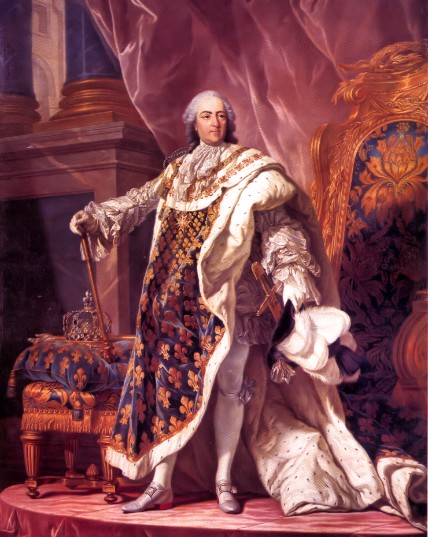 Louis-Michel van Loo, ca. 1723-1774, Palace of Versailles | Louis XV came of age in 1723, ending the reign of Philippe d'Orléans. Louis XV's reign, like his great-grandfather Louis XIV, was defined by his chief minister, in this case Andre-Hercule de Fleury. But when de Fleury died, Louis XV rarely participated in government. Also like his great-grandfather, Louis XV was immensely influenced by his "favorites," which usually meant "mistress," such as Madame de Pompadour. Under Louis XV, France regained the Duchy of Lorraine, which lay on the border between Eastern France and modern-day Germany. The Wars of Austrian Succession (1740-1748) and the Seven Years War (1756-1763) further bankrupted France due to the cost of involvement in foreign wars. France had been victorious in the war against Austria, gaining territory with each success. However, Louis XV returned the land back to Austria, winning popularity from his people. Later, in the Seven Years War, France lost most of its American possessions to Britain. At the end of Louis XV's reign in 1774, the near-constant warfare and the decadence of the court left the French monarchy weak and unstable, creating the environment in which the revolution would take place. After Louis XV's death, the throne was left to his grandson, Louis XVI. Like his forebears, Louis XV assumes the powerful stance symbolizing the strength of the monarchy. In addition to the virile pose, Louis XV is clad in the traditional robes of the royalty: blue, ermine-trimmed, and embroidered with gold fleur-de-lys. Like Louis XIV, Louis XV has a sword, which is ceremonious, although warfare was a central part of his reign. In addition to the sword, Louis XV is pictured with a crown and scepter, representing the divine right to rule. Is this portrait more effective than that of Louis XIV? In what ways? Knowing the a little background on each of the kings, do the propagandist messages change or retain their clarity? Does the king perhaps seem too confident, particularly knowing the state in which he left France? |
Due to the wars against the Austrian Hapsburgs beginning in 1740, France and Louis XV sought to create a political alliance between the Holy Roman Empire and France. The resolution was to marry the future Louis XVI to the Empress Maria Theresa's daughter, Marie Antoinette, thereby joining the two nations together to prevent further war. When his grandfather died in 1774, the twenty-year-old Louis XVI and his wife, the nineteen-year-old Marie Antoinette, became the ruling absolute monarchs of France. During his reign, appointed chief ministers, Jacques Turgot and Jacques Necker, to solve the nation's debt crisis. All the while, Marie Antoinette frivolously spent money on clothing, interior design, and entertainment. In 1776, when the American Colonists rebelled against Great Britain, France sent aid (soldiers, food, supplies) to the revolutionaries. The French people soon grew resentful of the French military efforts in North America because of the drain on the resources of the Treasury. Louis XVI continued to grow more unpopular. A series of bad crops plagued the Third Estate (the peasants and 98% of the French population). Louis XVI continued not to act, "further discrediting the monarchy." In a last-ditch attempt to assuage the volatile situation, Louis XVI called together the Estates-General, a governing body, similar to Parliament, with little actual power. However, the three Estates did not meet simultaneously, invoking the ire of the Third Estate, who then formed the National Assembly, a governing body based on representation (or a Republic). In response to the lack of acknowledgement by the monarchy, the Third Estate stormed the Bastille (a prison thought to contain arms) on July 14, 1789, beginning the French Revolution against the absolute monarchy. The royal family attempted to escape in 1791, spurring the National Assembly to force the king into signing a document for the creation of a constitutional monarchy. The next year saw the radicalization of the revolutionaries, known as The Reign of Terror. The newly formed National Convention abolished the monarchy, tried Louis XVI and Marie Antoinette, along with countless nobles, and sentenced them to death. Louis XVI was beheaded on January 21, 1793 at the age of thirty-eight. In the portrait to the right, Louis XVI is depicted in the full regalia of the royal house. The ermine, blue, and fleur-de-lys complete the ensemble. Like his forefathers, Louis XVI exhibits the sword, scepter, and crown as symbols of his military and absolute might. How did this image, which served as positive propaganda for Louis XIV and Louis XV, come to represent corruption and despotism? | King Louis XVI (1774-1792)  Antoine-François Callet, ca.1788, Musée national des Châteaux de Versailles et de Trianon |
Queen Marie Antoinette (1774-1792) 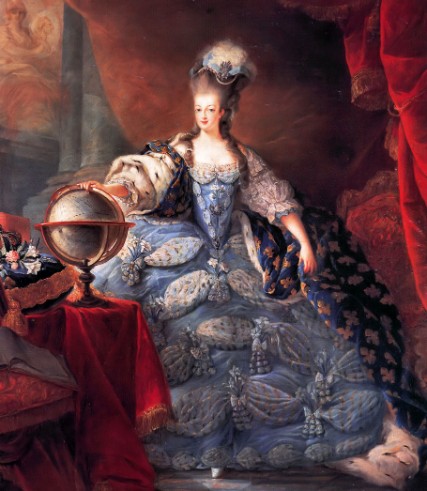 Jean-Baptiste Gaultier Dagoty, ca. 1775, Palace of Versailles | Maria Antonia was the eleventh daughter of the Empress of the Holy Roman Empire. Therefore, Maria Antonia's schooling was less of a priority than that of her ten sisters. This lack of focus to Maria Antonia's studies seriously inhibited her future rule as the Queen of France. In 1770, Maria Antonia wed the Dauphin of France, the future Louis XVI. When Maria Antonia moved to France, she was forced to change her name to Marie Antoinette. The young couple became the rulers of France in 1774 with the death of Louis XV. Both Marie Antoinette and Louis XVI were unprepared to rule, through their collective lack of education. While the royal couple got along well, they faced pressure from the state and from Marie Antoinette's mother to produce an heir. Their first child was born seven years after the wedding. To cope with the seven childless years, homesickness, and the pressure from the French court (she was known as l'Austrichienne, or Austrian bitch/dog), Marie Antoinette turned to frivolities. Marie Antoinette undertook a stylistic revolution, rivaling Louis XIV's in the previous century. This stylistic revolution, however, was not as well received as Louis XIV's because the French state had significantly more debt and significantly more starving peasants. In regard to clothing, artwork, and interior design, Marie Antoinette favored the Rococo style over the Baroque style that preceded it. Marie Antoinette was ridiculed for her outrageous fashion and her attachment to fashion designers, such as Rose Bertin. As the situation in France deteriorated, political cartoons spread throughout France, ridiculing the monarchy and the frivolity of the royal family. Rumors spread about Marie Antoinette, including gossip falsely implying that, when asked about the starving French peasants, she replied, "Let them eat cake." The unrest that was running rampant in France culminated in the storming of the Bastille prison on July 14, 1789 and the subsequent capture and imprisonment of the royal family. The French people fought to install an effective democratic government, all the while sending nobles and dissenters to the guillotine. Louis XVI was beheaded in January 1793. Marie Antoinette, hair turned white from shock and still imprisoned, was nicknamed "Widow Capet" (Capet being Louis XVI's surname). In October 1793, Marie Antoinette was guillotined at the age of thirty-seven. In the portrait to the left, Marie Antoinette is depicted in the traditional colors and emblems of the French royal family. Could the inclusion of the globe highlight France's colonies throughout the world and the absolute control exacted on them? The portrait was painted in 1775, just after the coronation of the royal couple. How could this portrait been seen as depicting a fashionable, promising young Queen in one decade and in the next a frivolous, spoiled, careless despot? |
The second son of Louis XVI and Marie Antoinette was just four years old when the revolution broke out in 1789, coincidentally, the year in which his older brother died. Louis XVII, then the Dauphin, was imprisoned with his parents after the storming of Bastille. After the death of Louis XVI in 1793, Louis XVII became the king only in title, as the Revolutionaries had declared France a Republic. During his internment, Louis XVII was reported to have been mistreated, which led to him signing the list of his mother's crimes as a witness just before her trial. Louis XVII continued to be imprisoned, changing hands many times before dying mysteriously in prison in 1795. Even in the midst of the French Revolution, the Dauphin is dressed in the traditional blue of the royal family. The sparse embellishments that decorate the king's attire speak to the tense atmosphere in which he lived, for as a royal portrait goes, this one is lacking the usual features, as seen in the above paintings. | King Louis XVII (1793-1795) 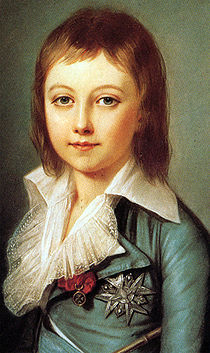 Alexander Kucharsky, ca. 1792, Palace of Versailles |
The First Republic of France:
First Consul Napoleon Bonaparte (1799-1804) 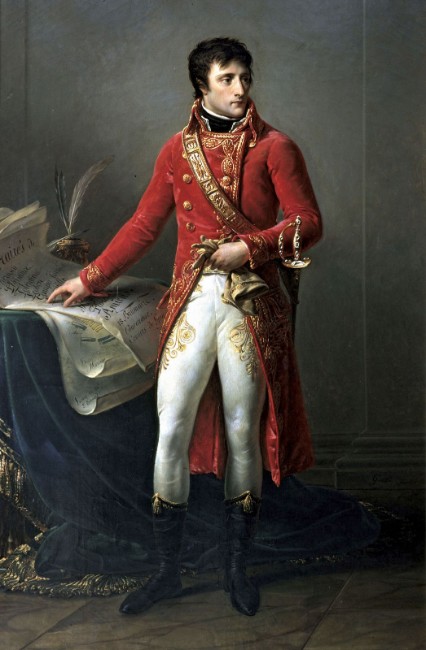 First Consul Bonaparte, Antoine-Jean Gros, ca. 1802 | After serving in a military capacity in foreign lands during the Revolution, Napoleon returned to political turmoil in France. Staging a coup d'état, Napoleon was established as France's First Consul of a tentative government. Napoleon suddenly became the most important person in France. Immediately, Napoleon deployed troops throughout Europe. In 1804, Napoleon declared himself the Emperor of the new French Empire. In the portrait to the left, Napoleon is pictured with documents symbolizing his dedication to his government. How is this image contradictory to his actions, especially the declaration regarding the Empire? Is it contradictory? What does the simple splendor of Napoleon's outfit project to the viewer? |
~All dates are dates of reign Format: Title (if available), Artist(s), Date, Current Location